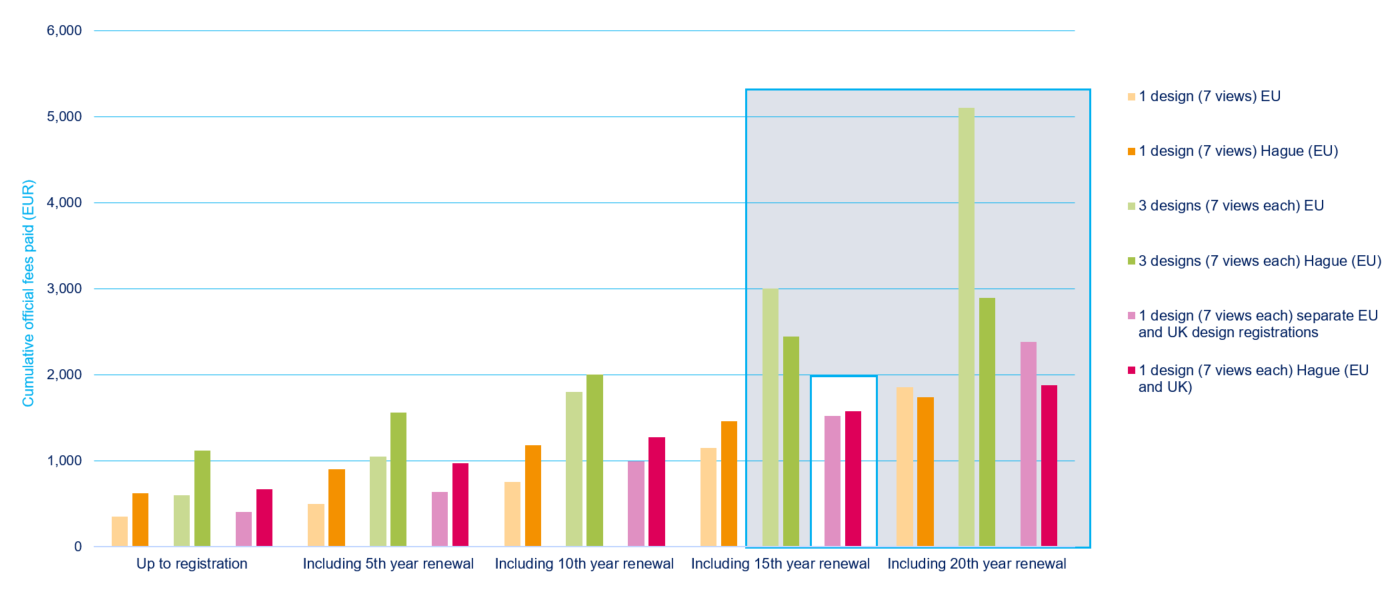Increase in renewal fee for EU designations in a Hague design registration
The European Union Intellectual Property Office (EUIPO) has notified its intention to the World Intellectual Property Organization (WIPO) to increase the official fee payable for renewing an EU designation from a Hague design registration. This increase will take effect from 19 May 2025, and will see the amount of the official fee effectively double from 30 CHF to 59 CHF.
The increase in this official renewal fee will come as no surprise to many, appreciating the upcoming implementation of the widely publicised EU design reform process, which is similarly set to increase the official fees payable for renewing an EU design registration that is pursued outside of the Hague design registration system (in other words, EU design registrations pursued via the EUIPO directly). Under this reform process, the official fees for renewing an EU design registration outside of the Hague system will increase as listed below, and will be applicable for any renewal fee paid on or after 01 May 2025.
Table of upcoming increase in official renewal fees for EU design registrations pursued before the EUIPO
| Renewal year | Official renewal fee prior to 01 May 2025 (EUR) | Official renewal fee from 01 May 2025 (EUR) |
|---|---|---|
| 5 | 90 | 150 |
| 10 | 120 | 250 |
| 15 | 150 | 400 |
| 20 | 180 | 700 |
The increase in these official renewal fees under the two routes (EUIPO or Hague) makes for interesting review when it comes to considering which of the two routes is the more economical for pursuing/maintaining design registration protection across the EU.
To help visualise this, reference can be made to the chart below, which shows the cumulative cost of pursuing/maintaining EU design registration protection over time under what will be the new official fees arrangements, and which depend on:
- the number of designs initially pursued;
- how long this protection is envisaged to be maintained for; and
- whether this protection is pursued alongside corresponding protection in the United Kingdom (which is a fairly common occurrence nowadays, following the UK’s departure from the EU).
The grey region from the chart identifies break-even points at which pursuing the Hague route becomes the more economical of the two routes, from an official fee perspective. Extrapolating this at a more summary level, it may be seen that where the intention is to maintain an EU design registration for its full 25 year term, for any number of designs, it will invariably be more economical from an official fee perspective to pursue this protection via the Hague route, rather than via the EUIPO.
Chart of cumulative official fees incurred for pursuing/maintaining EU design registration protection (EUIPO route v Hague route)

Appreciably however, most design registrations covering the EU are not maintained for their full 25 year term (typically less than 20%), which means that usage of the Hague route in many instances may not be the most appropriate. This is so, particularly when other factors might be at play, such as the need for a speedier registration (noting an EU design registration pursued via the EUIPO can be registered in less than a week, whereas usage of the Hague design registration system will typically take at least three months to obtain any enforceable design registration protection in the EU). In addition, many entities around the world are still not able to make use of the Hague design registration system, such as those based in Australia and New Zealand, noting the “closed” nature of the Hague system. So for such entities not having the requisite affiliation with a member state of the Hague design registration system, design registration in the EU for these entities is only possible via the EUIPO directly.
Clearly therefore, there is no one-size-fits-all approach for obtaining registered design protection in the EU, but particularly in instances where a number of designs are being contemplated for protection as a series of EU design registrations, and which are envisaged for protection for the entire 25-year term, it is worth being aware of the different levels of renewal fees which will need to be paid to keep these design registrations covering the EU in force, depending on whether this protection is obtained via the Hague system, or not.
Useful links
- WIPO, Hague information notice no. 4/2025, “Hague Agreement Concerning the International Registration of Industrial Designs” (PDF): https://dycip.com/wipo-hague-renewals-2025
- EUIPO, “EUIPO Statistics for Community Designs”, see in particular section 5, pages 1 & 2, “Direct RCD Renewals” noting that typically, fewer than 20% of design registrations pursued before the EUIPO are renewed for the full 25 year period (PDF): https://dycip.com/euipo-design-renewals
- WIPR website, “How Does the Hague System Work?”, see in particular heading “Who can use the Hague System?”: https://dycip.com/wipo-hague-overview

